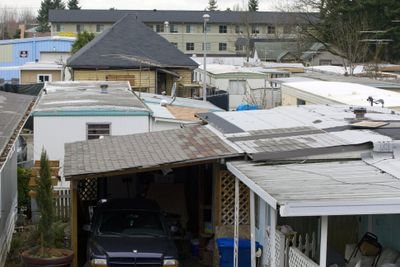Hendrix childhood home dismantled
Much of house will be cataloged, stored

RENTON, Wash. – The small house where rock guitarist and singer Jimi Hendrix is said to have first discovered music is being dismantled after preservation efforts failed.
As of Tuesday, barely a shell was left of the 900-square-foot home, which had been moved twice from its original location in the Central Area of Seattle, where Hendrix grew up.
Owner Pete Sikov, a Seattle real estate investor who spent eight years trying to preserve the dilapidated structure, told the Seattle Times that pieces of the house have been saved and may be sold later.
“Can you imagine a guitar made out of wood from Jimi’s house? Who wouldn’t want that?” he said.
Hendrix lived in the house from age 10 to 13 in the 1950s.
The house, purchased by his father, Al Hendrix, for a $10 down payment in 1950, was the first real home the struggling family had. Al and Lucille Hendrix’s marriage was collapsing, the electricity was sometimes shut off for nonpayment, and on occasion, the brothers were fed by neighbors.
It was there, said Leon Hendrix, the late musician’s younger brother, that Jimi Hendrix picked up a ukulele that had one string and figured out how to strum the theme from the television detective show “Peter Gunn.”
Later, said Charles R. Cross, author of the Hendrix biography “Room Full of Mirrors,” the budding musician rewired the family’s stereo as an amplifier and hooked up a borrowed guitar to fill the house with sound.
Sikov says his deconstruction crew is discarding the roof and additions that were made after the Hendrix family left.
Original parts, including kitchen cabinets, a claw-foot tub, the back door, and “literally a ton of other pieces,” will be labeled, cataloged and stored in a safe place, Sikov said.
Some pieces may be sold to raise money for First Place, which helps homeless children and has gotten assistance from Sikov in the past.
The house escaped the wrecking ball in 2001 after the site was purchased for condominium development. Sikov, 54, paid more than $30,000 to buy and move it to a city-owned site east of the International District, where he and the James Marshall Hendrix Foundation hoped to renovate it as a music center.
After the city moved to have the house demolished, Sikov paid $1.8 million to buy a three-acre trailer park across the street from the cemetery where Hendrix is buried in Renton, moved the house to the site and negotiated with the suburban municipality for a development plan with the home as a centerpiece. In all, Sikov spent more than $100,000 on the house itself.
“We thought it was a worthwhile gamble for the city to try and make it go,” said Neil Watts, Renton director of development services. “I mean, the number one question our Chamber of Commerce gets is, ‘Where is Jimi Hendrix buried?’ ”
Sikov said he negotiated unsuccessfully with several developers until Renton officials finally demanded the house be removed.
“It’s an eyesore,” Watts said. “We had this fairly ugly structure on a major arterial.”